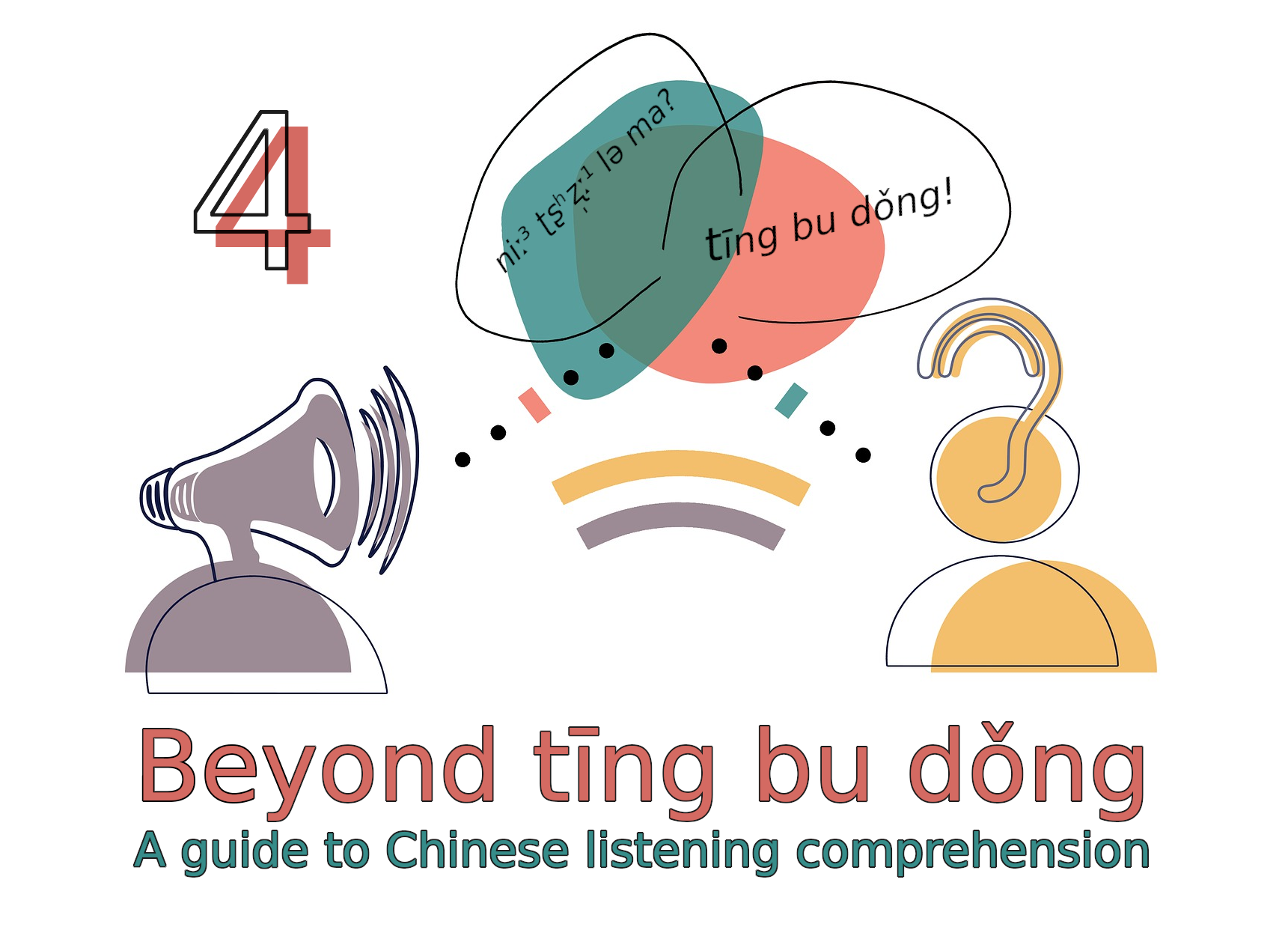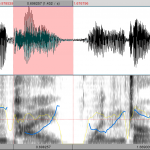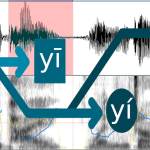 To understand spoken Chinese, we need to both extract information from what we hear, but we also need to use what we already know to interpret it.
To understand spoken Chinese, we need to both extract information from what we hear, but we also need to use what we already know to interpret it.
As we have seen in the previous two articles in this series, our brains need to process vast amounts of data rapidly for listening comprehension to be successful.
The reason we are able to do this in our native language(s) and that we can learn to do so in Mandarin too, is that the process becomes automated with experience.
As beginners, we are only able to process some things when paying attention to them, but we can’t focus on everything at once. As we listen to more Chinese and gradually become more familiar with the language, processing becomes automated and we’ll be able to deal with some things without paying attention to them or even being conscious of them.
Tune in to the Hacking Chinese Podcast to listen to the related episode:
Available on Apple Podcasts, Google Podcasts, Overcast, Spotify, YouTube and many other platforms!
Beyond tīng bu dǒng, part 4: Learning to process spoken Mandarin quickly and effortlessly
Most people never think about listening comprehension in their native language(s), a testament to how highly automated the processing is. The only time we pay attention to it is when external factors make it harder than usual, such as when the connection is bad in a voice call or when there’s too much echo or noise in the environment.
In the previous two articles in this series, we looked at bottom-up and top-down processing of spoken language. In this article, we will look at these processes from another angle, with a focus on what’s often called automated and controlled processing.
To put it briefly, automated processing deals with many things in parallel, but it’s not something we do consciously. Controlled processing, on the other hand, is conscious and we need to focus our attention for it to work, and because of this, it can only deal with one thing at a time.
The goal for us as language learners is to automate as much as possible, while also making sure we make the best possible use of controlled processing to deal with the rest.

This article is part of a series about listening comprehension in Mandarin. Here’s a list of the articles I’ve planned for this series so far. Article titles without links have not been published yet!
- A guide to Chinese listening comprehension
- From sound to meaning in Mandarin
- Using what you already know to aid listening comprehension in Chinese
- Learning to process spoken Mandarin quickly and effortlessly
- Becoming a better listener as a student of Chinese
- Why is listening in Chinese so hard?
- How to master different kinds of listening in Chinese
- Building an arsenal of Chinese listening strategies for every situation
- The best listening exercises to improve your Chinese
Controlled and automated processing: Spotlight vs. floodlight
One way of understanding these two types of processing is to say that our conscious effort to understand spoken language (controlled processing) is like using a spotlight to make sense of a rapid chase through a dense jungle at night; no matter how quickly we move the spotlight around, we can only look at one thing at a time, and the scenery changes so quickly that we will never get a good idea of the big picture.
Fortunately, we don’t need to consciously process everything. With experience and exposure to the language, we gain the ability to automatically process spoken language. This is more like a floodlight, albeit a rather weak one to begin with. Its light is not as bright, but in contrast to the spotlight, it isn’t directional and can illuminate the whole landscape all at once.
Understanding spoken Chinese is both about making efficient use of the spotlight, and more importantly, improving the strength and capacity of the floodlight.
Conscious processing and attention are more limited than you think
This will not come as surprise to anyone who has basic knowledge of cognitive psychology, but it’s amazing how limited our consciousness and attention are in comparison with what most people think (people who haven’t studied cognitive psychology, that is). I said above that the spotlight can only focus on one thing at a time, and for some of you this might sound exaggerated (it did to me when I first heard it).
According to most models of speech perception, you can’t focus on more than one conversation at once. To be more specific, you can’t pay attention to and process more than one thing at a time, which doesn’t necessarily mean that you can’t follow the gist in two simultaneous but separate monologues.
You could achieve this by switching attention between them very fast, which won’t let you process everything said in both conversations, but if your top-down listening is up to par, you can still fill in the missing pieces and (see part 3 in this series). This is very hard, though, even in one’s native language.
After reading about this years ago, I have tried to pay attention to two conversations at once many times, but the more I try, the more convinced I become that it’s not possible. The same goes for focusing on more aspects than one in a single conversation, although it’s possible to switch between several different things.
Switching focus isn’t always a good thing, though. The Cocktail Party Effect refers to the phenomenon of reacting to stimuli in an otherwise ignored channel, such as hearing one’s name in a different conversation from the one you’re having at a cocktail party (see Moray, 1959).
This has been linked to low working memory capacity (Conway, Cowan & Bunting, 2001), and the ability to focus one’s attention without distraction has positive effects on listening comprehension in general. Focusing on the right things is as important as being able to ignore irrelevant things.
From controlled to automatic processing in Mandarin
Let’s look at a few examples that most of you should be able to identify with:
 Learning to hear tones in Mandarin – Most beginners struggle with tones. Some might be able to hear the difference between a high, flat tone (first tone) and a low, falling tone (third tone), but it’s common to not hear the difference between a rising and a falling tone. However, as you keep listening and paying attention, you will learn what distinguishes the tones from each other. At first, this is effortful and requires your utmost attention, but when you’ve studied for a while, you will stop thinking about tones most of the time. This frees up a lot of controlled processing capacity that you can now use for other things. I’ve written more about learning to hear sounds and tones in Mandarin here: Learning to hear the sounds and tones in Mandarin.
Learning to hear tones in Mandarin – Most beginners struggle with tones. Some might be able to hear the difference between a high, flat tone (first tone) and a low, falling tone (third tone), but it’s common to not hear the difference between a rising and a falling tone. However, as you keep listening and paying attention, you will learn what distinguishes the tones from each other. At first, this is effortful and requires your utmost attention, but when you’ve studied for a while, you will stop thinking about tones most of the time. This frees up a lot of controlled processing capacity that you can now use for other things. I’ve written more about learning to hear sounds and tones in Mandarin here: Learning to hear the sounds and tones in Mandarin. Figuring out where one word ends and the next begins – Foreign languages often sound like an uninterrupted stream of gibberish. It’s not just that we don’t understand the words, it’s that we don’t even know how to separate a longer utterance into words (segmentation). This is because different languages do this in different ways, and it’s also common for words to be pronounced differently in different context to make them easier to say, which makes the boundaries less clear. Tone changes in Mandarin are a good example of this. Chinese is peculiar in that this segmentation issue is also present in the written language because we have no spaces between words, but this is of course also a problem when learning the spoken language. However, this becomes much easier over time and while you might still struggle recalling the meaning of words or with interpreting them as an intermediate learner, you will no longer find it hard to cut utterances up into words, even if you might not know the meaning of all of them. As you learn more about Mandarin syllable structure, you know that a syllable can’t end with a p and that reduced syllables with neutral tones never appear on the first syllable of a word. And so on.
Figuring out where one word ends and the next begins – Foreign languages often sound like an uninterrupted stream of gibberish. It’s not just that we don’t understand the words, it’s that we don’t even know how to separate a longer utterance into words (segmentation). This is because different languages do this in different ways, and it’s also common for words to be pronounced differently in different context to make them easier to say, which makes the boundaries less clear. Tone changes in Mandarin are a good example of this. Chinese is peculiar in that this segmentation issue is also present in the written language because we have no spaces between words, but this is of course also a problem when learning the spoken language. However, this becomes much easier over time and while you might still struggle recalling the meaning of words or with interpreting them as an intermediate learner, you will no longer find it hard to cut utterances up into words, even if you might not know the meaning of all of them. As you learn more about Mandarin syllable structure, you know that a syllable can’t end with a p and that reduced syllables with neutral tones never appear on the first syllable of a word. And so on. Understanding complex sentences – When you first start learning Chinese, word order seems very straightforward, because it’s the same as in English (SVO, or subject-verb-object, or 我爱你, wǒ ài nǐ). Soon, however, you realise that it’s not that easy, because even a simple phrase like “the person I love is completely different in English and Chinese. In Chinese, it’s 我爱的人 (wǒ ài de rén). This takes a while getting used to and you need to consciously find the 的 to untangle the sentence. To do this, you use up most of the controlled processing resources you have, but when you’ve reached an intermediate stage in your learning, you will no longer struggle with sentences like this: the process has become automated. John Pasden from Sinosplice and AllSet Learning wrote this great article about how to approach grammar in Chinese.
Understanding complex sentences – When you first start learning Chinese, word order seems very straightforward, because it’s the same as in English (SVO, or subject-verb-object, or 我爱你, wǒ ài nǐ). Soon, however, you realise that it’s not that easy, because even a simple phrase like “the person I love is completely different in English and Chinese. In Chinese, it’s 我爱的人 (wǒ ài de rén). This takes a while getting used to and you need to consciously find the 的 to untangle the sentence. To do this, you use up most of the controlled processing resources you have, but when you’ve reached an intermediate stage in your learning, you will no longer struggle with sentences like this: the process has become automated. John Pasden from Sinosplice and AllSet Learning wrote this great article about how to approach grammar in Chinese.
To summarise, the problem is that while you can focus on something specific and facilitate processing in that area (something we will discuss later in this series when we get to listening strategies), you can’t do this with everything at once.
You can’t focus your attention on tones while you also focus on word segmentation while you also try to figure out the grammatical structure of a sentence. This is why listening is so effortful in the beginning and also why it often fails. This is also why listening many times yields better and better results, even if no clues or extra information is added.
The only solution is to practice enough that these processes become more and more automated.
The importance of automated processing and how to practise to improve it
As second language learners, our cognitive resources often can’t cope with the demands put on them when listening to spoken Mandarin. These demands aren’t limited to listening itself either, because if you want to do something with what you hear, such as formulating your own response to a question somebody asks you, you also need processing capacity to interpret what they say, what you want to respond and how to phrase that in Chinese. For a conversation to flow naturally, you need to do this all while listening! This is clearly not possible if you need all the attention you can muster just to understand what’s being said.
The way forward is automation. You need to be so familiar with the spoken language that you can process sounds and tones instantly, recall words without delay, and put them all together without needing to think about it. Naturally, this won’t happen over night, but there is a simple way to learn this:
Listen more!
I said “simple” rather than “easy”, because of course, even if taking a single step is easy, walking a thousand miles isn’t . I have written a number of articles focusing on how to listen more, but here are the most popular ones:
1. Three steps to more and better Chinese listening practice
2. How to find more time to practise Chinese listening
3. 7 ideas for smooth and effortless Chinese listening practice
7 ideas for smooth and effortless Chinese listening practice
Listening practice here is defined as making sense of spoken Chinese. That means that if you don’t understand what you’re listening to, it’s too hard and you should find something else. Ideally, your listening should fulfil the requirements of meaning-focused input, which is the first of Paul Nation’s four strands, so not learning new words or grammar patterns.
Naturally, if you listen a lot, you will also learn more words and grammar, but only if the unknown language content is at a manageable level. In my experience, students spend too much time learning new things, and nowhere near enough consolidating what they’ve already learnt. I wrote about fluency development in detail in this article: How to become fluent in Chinese.
Conclusion: Listen more
All students should listen more. If you already think that you’re listening enough, you should probably still spend more time listening.
Those of you who don’t listen much outside class and your textbook audio once in a while should rethink the way you’re learning and find ways to include at least as much listening as all other forms of learning combined.
This might sound extreme, but it’s actually not very hard if you check the practical advice in the three articles linked to above.
You really can’t listen too much.
While you might regret that you spent a hundred hours on learning characters or grammar, you will never regret spending a hundred hours on listening. Naturally, the results won’t show immediately; it takes time for your brain to absorb enough information to make it truly useful, so give it a month or two before you decide if it’s helpful or not. If you’ve reached the intermediate plateau or even beyond it, you should expect to persevere even longer before you start seeing substantial progress.
More listening will boost not just your listening, but all other areas of the language as well!
Now that we have covered the basic aspects of listening ability in Chinese, we’re going to turn to factors that influence listening comprehension, namely who’s listening (listener factors), what type of listening it is (situational factors) and finally what languages are involved (language factors).
Stay tuned for the next installment in this series, and sign up to the newsletter below if you haven’t already!
References and further reading
Conway, A. R., Cowan, N., & Bunting, M. F. (2001). The cocktail party phenomenon revisited: The importance of working memory capacity. Psychonomic bulletin & review, 8(2), 331-335.
Field, J. (2009). Listening in the Language Classroom. Cambridge University Press.
Moray, N. (1959). Attention in dichotic listening: Affective cues and the influence of instructions. Quarterly journal of experimental psychology, 11(1), 56-60.
Rost, M. (2011). Teaching and researching: Listening (2nd ed.). Routledge.
Vandergrift, L. (2011). Second language listening: Presage, process, product, and pedagogy. In Handbook of research in second language teaching and learning (pp. 455-471). Routledge.
Vandergrift, L., & Goh, C. (2012). Teaching and learning second language listening: Metacognition in action. Routledge.
